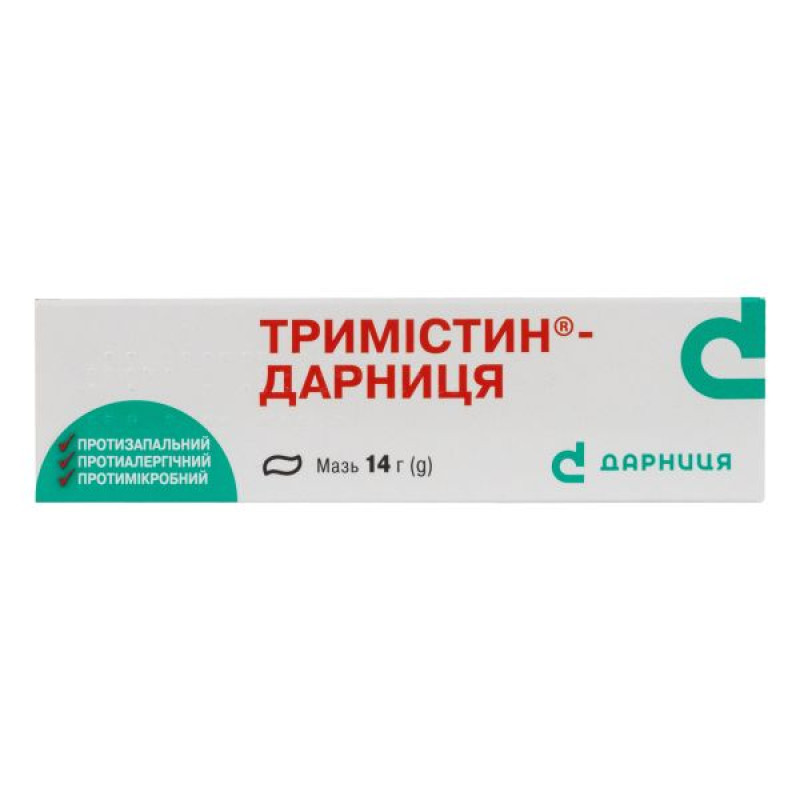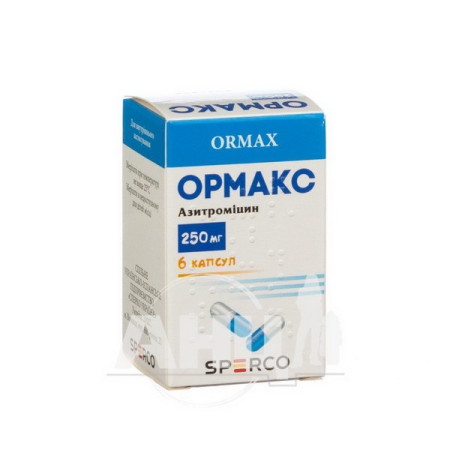Trimistin-Darnitsa ointment for external use tube 14 g

Instructions Trimistin-Darnitsa ointment for external use tube 14 g
Composition
active ingredients: 1 g of ointment contains micronized triamcinolone acetonide 0.25 mg, miramistin 5 mg;
excipients: propylene glycol, betacyclodextrin, cetyl alcohol, stearyl alcohol, purified water.
Dosage form
Ointment.
Main physicochemical properties: white ointment, gel-like consistency, with a faint specific odor, should be homogeneous in appearance.
Pharmacotherapeutic group
Corticosteroids in combination with antiseptics.
ATX code D07B B03.
Pharmacological properties
Pharmacodynamics
Ointment "Trimistin®-Darnitsa" is a combined drug for topical use. The active ingredients are triamcinolone acetonide and miramistin.
Triamcinolone is a fluorinated glucocorticosteroid that has a pronounced anti-inflammatory, anti-allergic and anti-exudative effect. Interacting with a specific protein receptor in target tissues, it regulates the expression of corticoid-dependent genes and affects protein synthesis. Reduces the formation, release and activity of inflammatory mediators (histamine, kinin, prostaglandins, lysosomal enzymes). Inhibits cell migration to the site of inflammation; reduces vasodilation and vascular permeability in the focus of inflammation. Stabilizes lysosomal enzymes of leukocyte membranes; inhibits antibody synthesis and disrupts antigen recognition. Inhibits the release of interleukin-1, interleukin-2, gamma interferon from lymphocytes and macrophages. Induces the formation of lipocortin, inhibits the release of inflammatory mediators by eosinophils and stabilizes mast cell membranes. All of these effects suppress the inflammatory response in tissues in response to mechanical, chemical, or immune damage.
Miramistin is a broad-spectrum antiseptic agent, has a bactericidal effect (hydrophobic interaction with the membranes of microorganisms leads to their destruction). It is effective against gram-positive (including Staphylococcus spp., Streptococcus spp., Streptococcus pneumonia) - mainly and gram-negative microorganisms (including aerobes and anaerobes), spore-forming and non-spore-forming microflora in the form of monocultures and microbial associations (including hospital strains with multi-resistance to antibiotics). It has an antifungal effect on ascomycetes of the genus Aspergillus and the genus Penicillium, yeast fungi (Rhodotorula rubra, Torulopsis gabrata and others) and yeast-like fungi (Candida albicans, Candida tropicalis, Candida krusei and others), dermatophytes (Trichophyton rubrum, Trichophyton mentagrophytes, Trichophyton verrucosum, Trichophyton schoenleinii, Trichophyton violaceum, Epidermophyton Kaufman-Wolf, Epidermophyton floccosum, Microsporum gypseum, Microsporum canis and others), as well as on other pathogenic fungi, such as Pityrosporum orbiculare (Malassezia furfur), in the form of monocultures and microbial associations, including fungal microflora with resistance to chemotherapeutic drugs. Under the action of Miramistin, the resistance of microorganisms to antibiotics decreases. Effectively prevents wound infection, activating regeneration processes.
Pharmacokinetics
The physicochemical properties of the ointment base, as well as the high-molecular polymers in the base with sorption properties, retain the active components of the ointment at the site of application and prevent their diffusion into the systemic bloodstream.
Indication
Inflammatory skin diseases, in particular those complicated by bacterial or fungal infections: eczema, atopic dermatitis, neurodermatitis, psoriasis in the advanced stage and in the exudative form, parapsoriasis, pemphigus, contact dermatitis, seborrheic dermatitis, Duhring's dermatitis, discoid lupus erythematosus, photodermatosis, skin lymphoma.
Contraindication
Hypersensitivity to triamcinolone and miramistin or to other components of the drug. Skin tuberculosis localized at the site of application of the ointment; viral skin lesions, especially herpes simplex and chickenpox; parasitic infections (scabies); syphilitic skin lesions; widespread plaque psoriasis; skin reactions after vaccination; varicose veins; leg ulcers; perianal and genital itching; facial skin lesions (rosacea, acne vulgaris, perioral dermatitis); diaper rash caused by wet diapers; treatment of dry peeling skin and application of the ointment to the chest immediately before breastfeeding. Skin cancer.
Interaction with other medicinal products and other types of interactions
The effect of the ointment is partially weakened when applied to surfaces with a high content of purulent-necrotic masses. Therefore, it is better to apply the ointment to the skin after treating it with a warm soapy solution or, if necessary, with antiseptic solutions.
Products containing anionic surfactants (soap solutions) inactivate the drug.
With the simultaneous use of Miramistin with systemic or local antibiotics, a decrease in the resistance of microorganisms to the latter is observed.
Application features
During application of the cream, microorganisms present on the skin (primarily pyogenic microorganisms, sometimes blastomycetes) can penetrate the loosened stratum corneum and cause various pyodermas, which are treated with rinse-off disinfectants.
Do not use the drug in ophthalmological practice. Do not allow the drug to get into the eyes, and do not apply the ointment to the skin around the eyes, as this may lead to the development of glaucoma, cataracts, fungal eye infections, and exacerbation of herpes infection.
If skin irritation or signs of hypersensitivity occur due to the use of the ointment, treatment should be discontinued and the patient should be given adequate therapy. Prolonged use of the drug on the skin of the face is not recommended, as side effects may be increased. The ointment should not be used to treat varicose ulcers.
In the case of prolonged use of the drug and when using occlusive dressings on the same area of the body, skin atrophy may develop, and when treating large body surfaces, systemic side effects from the endocrine system are possible. These side effects develop extremely rarely, are reversible and disappear immediately after discontinuation of the drug. For such patients, regular monitoring of the function of the hypothalamic-pituitary-adrenal system is necessary during the period of use of the ointment. If symptoms of suppression of the function of the hypothalamic-pituitary-adrenal system appear, the drug should be discontinued or the intervals between ointment applications should be increased.
The use of topical steroids for the treatment of psoriasis may in some cases lead to relapse of the disease, development of tolerance, increase the risk of generalized pustular psoriasis and the development of local or systemic (reversible suppression of the hypothalamic-pituitary-adrenal axis) toxicity due to reduced skin barrier function. Therefore, careful patient care is important when treating psoriasis with a drug.
Some areas of the body, such as the armpits and inguinal folds (where there is natural occlusion), are more prone to the risk of striae and easily noticeable atrophy of this area of skin, which is irreversible. Therefore, the use of the drug in these areas should be short-term.
In the event of fungal or bacterial superinfection of the skin, additional use of an antifungal or antibacterial agent is necessary.
It is not recommended to use the ointment on the scalp.
Use during pregnancy or breastfeeding
The use of the cream in the first trimester of pregnancy is contraindicated. The question of the use of the drug during pregnancy in the second and third trimesters and during breastfeeding is decided by the doctor in each case individually, carefully weighing the ratio of the expected effect of treatment for the mother and the potential risk to the fetus/child. Data confirming the safety of the drug during pregnancy in the second and third trimesters are insufficient.
The absorption of glucocorticosteroids into the circulatory system is accompanied by their penetration into breast milk, affecting the adrenal cortex and growth of the infant.
It is contraindicated to apply the ointment to the skin of the breasts immediately before breastfeeding.
Ability to influence reaction speed when driving vehicles or other mechanisms
Usually, the drug does not affect the patient's reaction speed when driving or operating other mechanisms. However, it is recommended to exercise special caution when driving or operating other mechanisms, given the possibility of developing undesirable reactions from the nervous system.
Method of administration and doses
For external use.
In case of exudation, before applying the drug, treat the erosive surface with solutions of boric acid 1%, hydrogen peroxide 3% or chlorhexidine bigluconate 0.05%. If necessary, apply the ointment under a sterile gauze bandage.
Adults: apply a thin layer of ointment 1-2 times a day to the affected area of skin (maximum dose - for adults no more than 15 g of ointment per day) or apply the drug under an occlusive dressing (maximum dose - 10 g of ointment per day). The duration of treatment is determined by the doctor individually.
The drug should be used with caution and for a short time in elderly patients, as it should be borne in mind that the skin in this category of patients is thinner.
Children
Since there is insufficient experience with the use of Trimistin®-Darnitsa ointment for the treatment of children, it should not be used in pediatric practice.
Overdose
When applying the ointment to large areas of affected skin, the possibility of partial entry of the active components of the ointment into the systemic bloodstream in quantities that are not capable of causing acute poisoning cannot be ruled out.
In case of overdose of the drug, treatment should not be stopped abruptly - this should be done gradually, reducing the dose of the drug. If symptoms of adrenal insufficiency develop, intravenous administration of hydrocortisone may be required. Treatment is symptomatic.
Adverse reactions
On the part of the organs of vision: cataract, posterior subcapsular cataract, exophthalmos, glaucoma, optic nerve head swelling, corneal ulcer, exophthalmos. The probability of developing cataracts is higher in children.
Gastrointestinal: gastric bleeding, gastrointestinal bleeding, gastrointestinal perforation, esophagitis, pancreatitis, peptic ulcer.
From the nervous system: mental disorders, convulsions, dizziness, headache, increased intracranial pressure, insomnia.
Cardiovascular system: heart failure, arterial hypertension.
Immune system disorders: hypersensitivity reactions.
Skin and subcutaneous tissue: hyperemia, burning sensation, irritation, dryness, hypersensitivity, skin thinning, folliculitis, hirsutism, acneiform eruptions, hypopigmentation, perioral dermatitis, facial erythema and telangiectasias, increased sweating, striae formation, allergic contact dermatitis, diaper rash, secondary infections, delayed wound healing, increased swelling, itching, weeping, skin atrophy, delayed skin test reactions, contact eczema, steroid acne, purpura.
Musculoskeletal and connective tissue disorders: growth retardation in children, steroid myopathy, osteoporosis, osteonecrosis, aseptic necrosis.
Infections and parasitic diseases: activation of latent infections, masking of the course of infections, opportunistic infections.
Systemic manifestations: in some patients, with prolonged use on a large surface, the development of systemic side effects is possible: suppression of the function of the adrenal cortex, decreased tolerance to carbohydrates, Itsenko-Cushing's syndrome; negative nitrogen balance is possible due to increased protein breakdown.
From the side of water and electrolyte metabolism: suppression of the function of the adrenal cortex (secondary adrenal insufficiency), hypokalemic alkalosis, water and sodium retention in the body, hypokalemia, arterial hypertension.
Laboratory abnormalities: increased intraocular pressure, negative nitrogen balance, slowed reactions to skin tests.
Expiration date
2 years.
Storage conditions
Store in original packaging at a temperature not exceeding 25 ° C. Do not freeze.
Keep out of reach of children.
Packaging
14 g in a tube; 1 tube in a pack.
Vacation category
Without a prescription.
Producer
PrJSC "Pharmaceutical Company "Darnitsa".
Location of the manufacturer and its business address
Ukraine, 02093, Kyiv, Boryspilska St., 13.
There are no reviews for this product.
There are no reviews for this product, be the first to leave your review.
No questions about this product, be the first and ask your question.









